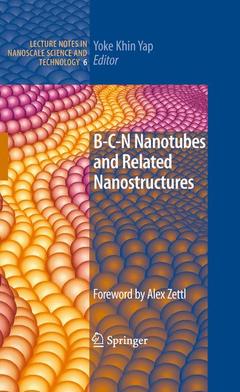Description
B-C-N Nanotubes and Related Nanostructures, 2009
Lecture Notes in Nanoscale Science and Technology Series, Vol. 6
Coordinator: Yap Yoke Khin
Language: English
299 p. · 15.5x23.5 cm · Paperback
Approximative price 158.24 €
Subject to availability at the publisher.
Add to cartSupport: Print on demand
Description
/li>Contents
/li>Biography
/li>Comment
/li>
Carbon nanotubes (CNTs) and Boron nitride nanotubes (BNNTs) are part of the so-called B-C-N material system, which includes novel nanostructures of carbon (C), doped-carbon, boron (B), boron nitride (BN), carbon nitride (CNx), boron-carbon nitride (BxCyNz), and boron carbide (BxCy). BNNTs and CNTs are structurally similar and share extraordinary mechanical properties, but they differ in chemical, biological, optical, and electrical properties. Therefore, hybrid nanotubes constructed of B, C, N elements are expected to form a new class of nanotubes with tunable properties between those of CNTs and BNNTs. In addition, these B-C-N nanostructures will further enhance and complement the applications of CNTs and BNNTs. With contributions from leading experts, B-C-N Nanotubes and Related Nanostructures is the first book to cover all theoretical and experimental aspects of this emerging material system, and meets the need for a comprehensive summary of the tremendous advances in research on B-C-N materials in recent years.
Chapter 1: Introduction to B-C-N Materials Chee Huei Lee, Jiesheng Wang, Vijaya Kayastha, Yoke Khin Yap (Dept. of Physics, Michigan Tech Univ., USA)
Chapter 2: Multiwalled Boron Nitride Nanotubes: Growth, Properties, and Applications Jiesheng Wang, Chee Huei Lee (Dept. of Physics, Michigan Tech Univ., USA) Dmitri Golberg (National Institute for Materials Science/NIMS, Japan) Yoshio Bando (National Institute for Materials Science/NIMS, Japan) Yoke Khin Yap (Dept. of Physics, Michigan Tech Univ., USA)
Chapter 3: Single Wall Nanotubes of Boron Nitride, Carbon Nitride, and Boron-Carbon Nitride Raul Arenal (Argonne National Laboratory) Annick Loiseau (LEM, CNRS-ONERA, France) LEM-Laboratoire D’etude des Microstructres, CNRS-Centre National de la Recherche Scientifique, ONERA-Office National d'Etudes et de Recherches Aérospatiales
Chapter 4: Electronic Properties of Boron Nitride and Boron-Carbon Nitride Nanotubes, and Related Heterojunctions Xavier Blasé (Laboratoire de Physique de la Matière Condensée et Nanostructures/LPMCN, Université Lyon 1, France) Pr. Helio Chacham (Dept. de Física, Universidade Federal de Minas Gerais/UFMG, Brazil)
Chapter 5: Vibrational and Optical Properties of Boron Nitride Nanotubes Ludger Wirtz (Institute for Electronics, Microelectronics, and Nanotechnology /IEMN, France) Angel Rubio (Dept. Material Physics, University of the Basque Country, European Theoretical Spectroscopy Facility/ETSF, and Donostia International Physics Center /DIPC, Spain)
Chapter 6: Boron Nitride Nanocage Clusters, Nanotubes, Nanohorns, Nanoparticles and Nanocapsules Takeo Oku (Institute of Scientific and Industrial Research/ISIR, Osaka University, Japan) et. al.
Chapter 7: Carbon Nitride and Boron Carbon Nitride Nanostructures Jie Yu (Harbin Institute of Technology) Enge Wang (Institute of Physics, China)
Chapter 8: Properties andApplications of Doped Carbon Nanotubes Antonio G. Souza Filho (Dept. De Fisica, Univ. Federal do Ceara, Brazil) Mauricio Terrones (Adv. Mat. Dept., IPICyT, Mexico)
Chapter 9: Boron and Boron Carbide Nanotubes and Nanostructures Kah Chun Lau (Dept. of Physics, Michigan Tech Univ., USA) Yoke Khin Yap (Dept. of Physics, Michigan Tech Univ., USA) Ravi Pandey (Dept. of Physics, Michigan Tech Univ., USA)
Professor Yoke Khin Yap received his Ph.D. in 1999 from Osaka University as a "Monbusho" scholar. He was a fellow of the Japan Society for the Promotion of Science (JSPS) before joining Michigan Tech in 2002. Professor Yap received the National Science Foundation CAREER Award in 2005. He has published more than 140 articles including book and encyclopedia chapters, review papers, peer-reviewed articles, and conference proceedings. His research program at Michigan tech has been supported by the U.S. Department of Army (DOA), National Science Foundation (NSF), Defense Advanced Research Projects Agency (DARPA), the U.S. Department of Energy (DOE), the U.S. Department of Agriculture (USDA), and multiple DOE Nanoscale Science Research Centers. Professor Yap is also the first elected Chair of the user group of the Center for Nanophase Materials Sciences at Oak Ridge National Laboratory.




